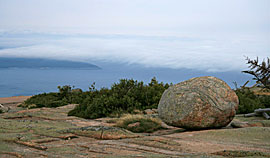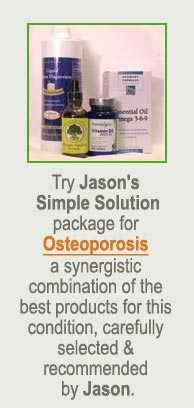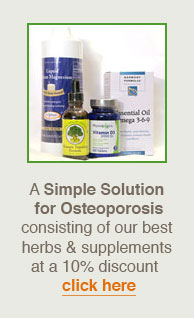WESTERN INTERPRETATION AND TREATMENT
Osteoporosis is a potentially serious condition involving a decrease in bone mass and an increase in bone brittleness; it is most common in postmenopausal women. The causes are multi-factorial and include genetic predisposition, estrogen depletion, lack of exercise, unhealthy eating habits, smoking, and alcohol consumption. Bone Scans are used to determine bone density and porosity.
Most physicians view osteoporosis as a symptom of hormonal deficiency, with estrogen depletion as the primary culprit. Estrogen replacement therapy, or ERT, has traditionally been the treatment of choice; however, due to the significantly increased risk of estrogen- related cancers, synthetic progesterones are now added and the treatment is labeled hormone replacement therapy, or HR T. HR T prevents osteoporosis, but once a woman stops taking the drugs, the bone loss continues and often escalates. Therefore, HR T is considered a lifetime commitment. Calcium supplements and exercise are also recommended to improve bone density and elasticity.
FIVE ELEMENT HEALING INTERPRETATION
In Chinese thought, the Kidneys rule the bones, and osteoporosis is thought to reflect diminished Kidney function, especially the yin (fluid) energy. Kidney decline is viewed as a natural part of aging, and some loss of bone density is expected and considered normal. Only when the bone loss is excessive or interferes with aging gracefully are aggressive treatments suggested. As always in Traditional Chinese Medicine, prevention is emphasized.
COMPLEMENTARY TREATMENTS
SUPPLEMENTS
 Calcium citrate, either in calcium-fortified orange juice, calcium citrate, gluconate, or lactate capsules, 500 -1,000 mg/day. (Avoid dolomite, bonemeal, and oyster shell, which contain lead and other harmful minerals; also avoid antacids, which are difficult to absorb and assimilate and can cause kidney stones or build up in joints, aggravating arthritic conditions.)
Calcium citrate, either in calcium-fortified orange juice, calcium citrate, gluconate, or lactate capsules, 500 -1,000 mg/day. (Avoid dolomite, bonemeal, and oyster shell, which contain lead and other harmful minerals; also avoid antacids, which are difficult to absorb and assimilate and can cause kidney stones or build up in joints, aggravating arthritic conditions.)- Magnesium, to assist in the absorption of calcium into the bones (Take twice as much magnesium as calcium, 500-1,000 mg/day calcium and 1,000-2,000 mg/day magnesium.)
- Vitamin D to increase absorption of calcium (2000 IU/day) Mounting clinical evidence suggests that Vitamin D can have a major impact on not only bones but also prostate, breast, ovary and colon cell health. Variations in Vitamin D in the diet, exposure to sunlight, environmental conditions, gastrointestinal absorption, and genetic polymorphisms suggest that most adults should supplement with Vitamin D to ensure adequate intake and plasma concentrations.
Vitamin D is an essential nutrient that works with Calcium to help develop strong bones and teeth. This high-potency Vitamin D supplement also assists in maintaining a healthy immune system. If you’re not getting enough Vitamin D every day, you may not be able to adequately absorb calcium from the foods you eat, and your body will have to take calcium from your bones. (Sunlight is critically important to the body’s ability to assimilate vitamin D; try to spend fifteen to twenty minutes every day in direct sunlight.) - Zinc to support the bones, the immune system, and Kidney energies (30-50 mg/day)
- Natural progesterone cream prevents and reverses osteoporosis by helping to build new bone. (Estrogen retards the breakdown of old bone cells, but many complementary practitioners believe that estrogen can actually contribute to harder, less flexible bones. Since natural progesterone is a precursor to estrogen, progesterone cream may be sufficient for prevention and treatment of osteoporosis.)
- Omega-3 fatty acids (eicosapentaenoic acid or EPA): These anti-inflammatory agents have general supportive effects on the circulatory system and a specific ability to reduce blood cholesterol levels. Omega-3′s reduce the joint stiffness and soreness caused by rheumatoid arthritis and improve flexibility. They are found in cold-water fish such as salmon, mackerel, herring, anchovies, sardines, and tuna. Eat two or three servings offish weekly, or take a 1,500-mg. supplement daily.
- Gamma linoleic acid: GLA has well-documented anti-inflammatory actions and a balancing effect on the immune system. As many researchers and clinicians theorize, arthritis and other autoimmune diseases are caused in part by the body’s inability to manufacture GLA and other essential fatty acids. So this is a particularly important supplement for arthritis patients. GLA is available in oil of evening primrose, borage seed oil, and black currant seed oil. Take 1,500 mg. daily. GLA and omega-3′s work well together and are often found in combined formulas. Whether you take them separately or in one formula, make sure you get 1,500 mg. of each daily.
EXERCISE
Since inactivity or lack of proper exercise can lead to bone loss, weight-bearing exercises-such as running or brisk walking while carrying light weights, bicycling, aerobics, and stair-stepping is strongly advised. Incorporate weight-bearing exercises into your lifestyle by parking your car a distance away from the store and carrying your groceries or packages.
DIET
Add calcium- and magnesium-rich vegetables (spinach, kale, broccoli, seaweeds); also add seeds, nuts, legumes, whole grains, nonfat :yogurt, and seafood. Avoid the following foods, beverages, or drugs, which contribute to calcium loss or interfere with calcium absorption: caffeine, alcohol, nicotine, sugar and refined carbohydrates, excess protein (meats, dairy, poultry), and phosphates (colas and root beer).
HERBAL ALLIES
 The following herbs may be used alone or combined in equal parts to make a wonderful tonic:
The following herbs may be used alone or combined in equal parts to make a wonderful tonic:
- Nettles, (Urtica dioica) also called stinging nettles, have a strong spiritual heritage and were used traditionally to remove curses or spells, directing them back to the sender (thus the sting). An extremely powerful and invasive plant, nettles extract high concentrations of nutrients from the soil and are especially rich in iron, vitamin C, calcium, and chlorophyll; these and other nutrients in the plant have powerful and diverse effects on the human body. Nettles have been used with great success to treat arthritic diseases and inflammations, to support kidney and bladder functions, and to control hemorrhaging. The Native Americans used nettles primarily as a gynecological herb and general womb tonic to increase fertility, support pregnancy, control bleeding during childbirth, and ease the transition through menopause.
Common Uses:
• Promotes fertility
• Stimulates milk in nursing mothers
• Acts as a superfood to ensure good nutrition and health during pregnancy
• Establishes regular menstrual cycles
• Stems heavy bleeding or hemorrhages from the womb (also used for nosebleeds, coughing up of blood, and other hemorrhages)
• Nourishes the kidneys and adrenal glands (excellent for arthritis and gout, helping to excrete uric acid and other toxic metabolites)
• Creates strong. flexible bones
• Strengthens nervous system, increasing stamina and energy without stressing nerves
• Relieves menopausal symptoms such as anxiety, depression, fatigue, irritability, mood Swings, and exhaustion
• Thickens and nourishes vaginal tissues
• Reduces vaginal itch and burning associated with yeast infections
- Horsetail (Equisetum arvense), a plant rich in silica, which is essential to healthy bones. Also known as bottlebrush, and shavegrass, was used by both Native Americans and Chinese Herbalists for centuries. Traditionally it has been used topically for the treatment of wounds and broken bones and internally, because of its high mineral content for the repair and reinforcement of bone structures. Though Silica is vital and essential for growth and nourishment of human connective tissues (which includes bone, cartridge, skin) it is extremely rare to find a naturally occurring source of it that is bio-available to the cells. Horsetail by far stands alone in this regard.
Common uses:
• Used for the growth and repair of human connective tissue
• Used as a poltice for wounds and broken bones
• Used as an effective treatment of urinary tract infections
• Has been used in the treatment of arthritis particularly gout
As Osteoporosis is often a complication of menopause, these herbs would be best utilized in combination with menopausal balancing herbs. Please see our In Depth Solution for Menopause.
COMPLEMENTARY HERBAL FORMULATIONS:
(Traditionally, in both Western and Chinese cultures, the combining of herbs is of superior value than the individual parts. After over thirty years as an herbalist, the synergy of certain herbs became apparent and this understanding has been used to create our own Integral Health Apothecary formulas. We are also listing tradition Chinese herbal tonics which exemplify this synergy.)
- Integral Health Apothecary’s Womens Transition Formula was created this by Jason for women navigating the menopausal years. Derived from both western and eastern herbal traditions, the balancing herbs in this formula combine perfectly help to ease the transition and support the bodys ability to shift more smoothly. Ingredients: Rehmannia Root (Rehmannia glutinosa), Chasteberry, (Vitex Agnus-Castus) ), Oatstraw (Avena sativa), Dong Quai (Angelica sinensis), St. Johns Wort ( Hypericum preforatum), Siberian Ginseng (Eleuthrococcus senticosus), Motherwort (Leonorus cardiaca) and Red Raspberry Leaf (Rubus ideaeus).
CHINESE PATENT REMEDIES
- Liu Wei Di Huang Wan (Six Flavor Rehmania Pill) for deficient Kidney yin, or
- Shou Wu Chih, a wine-type beverage containing shou wu (polygonum multiflorum), Dong Quai, and ginseng (one tablespoon twice daily) to support the Kidney jing and help you age gracefully
ACUPOINTS
MIND/BODY/SPIRIT CONNECTION
The symptoms might be expressing these questions:
- “How am I lacking support?”
- “How can I sustain my energies and, when I need support, ask for assistance from others?”
- “What is my foundation-how can I make it stronger?”
- “Where have I become hard, brittle, or rigid? What can I do to become more flexible and adaptable?”

